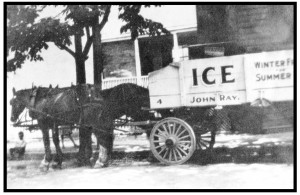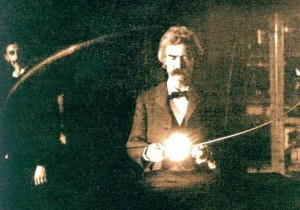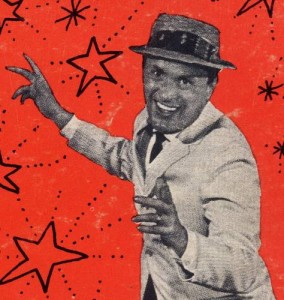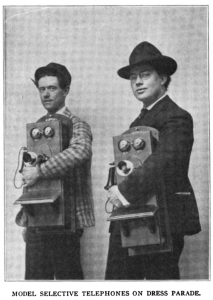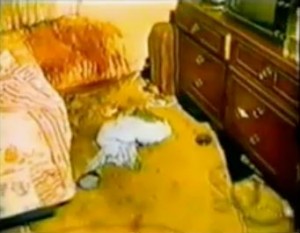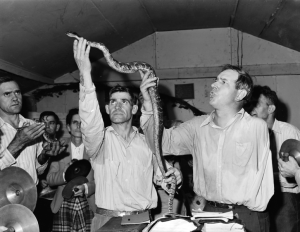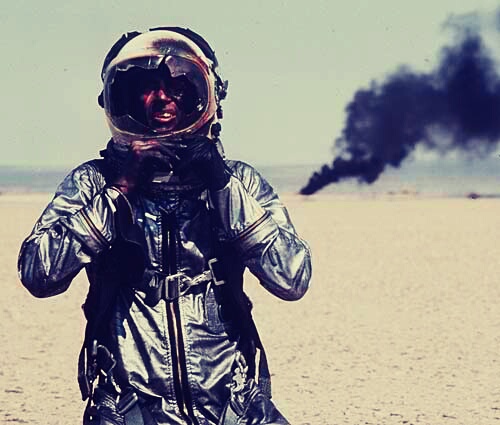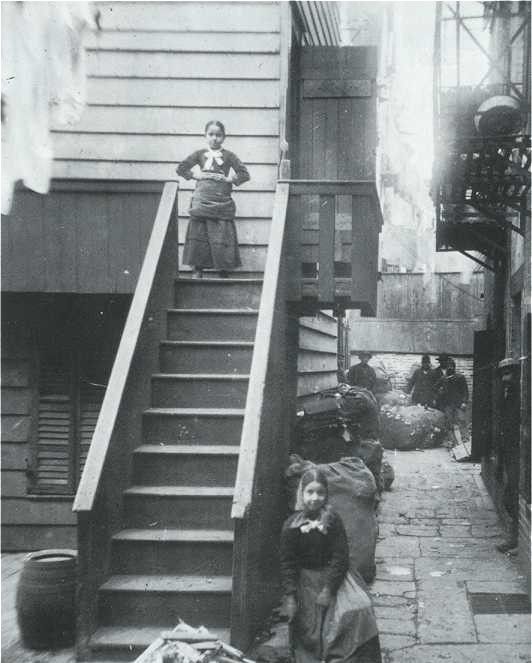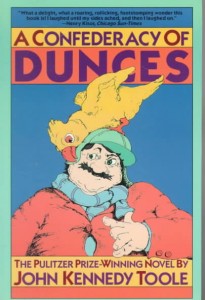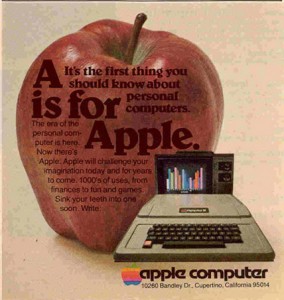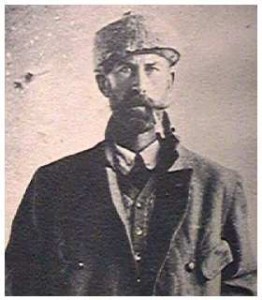The size of a quarter and able to communicate with one another, Kilobots cost $14 each and display collective behavior. (Thanks IEEE Spectrum.)
Sally Ride became the first American female to travel into space in 1983, and those enlightened designers at Mattel’s Barbie division were ready to pay tribute to the progress of women–well, to a point. Astronaut Barbie was a trailblazer in outer space, but she also enjoyed dancing in high heels under a disco ball. Seemingly intended for young girls with serious cocaine problems.
In the days before refrigeration, let alone air conditioning, New Yorkers depended on ice wagons to deliver to them freezing blocks of comfort and survival. In Brooklyn alone in the 1880s, residents required 50,000 tons of ice each summer. That meant a lot of ice wagons on the streets and plenty of mishaps resulting from them, as the following stories from the Brooklyn Daily Eagle demonstrate.
••••••••••
“Undertaker Kane Was Thrown From His Wagon” (May 26, 1885): “Benjamin Kane, an undertaker doing business on Sixth Street, near North Fifth, was thrown from his wagon on North Second Street, after colliding with an ice wagon last Wednesday, and sustained injuries from which he has since died.
Mr. Kane, who was a young man and not long ago married was well known to the Fourteenth Ward. The young wife was so stricken with grief at the demise of her husband that her life hung in the balance for twelve hours. She is now considered out of danger.”
••••••••••
“Hurt By a Cake of Ice” (August 12, 1895): “John Hilken, 26 years old, at 427 Marcy Avenue, was loading his ice wagon at the foot of Hewes Street this morning, when he was accidentally cut over the eye with an ice pick. George Wood, another ice man of 60 Sumpter Street, fainted at the sight of blood and when an ambulance surgeon arrived to treat Hilken, he found that Wood was more in need of attention. Hilken’s wound was sewed up and Wood was restored to consciousness to be laughed at by fellow ice men.”
••••••••••
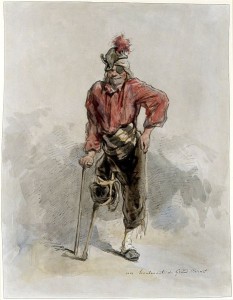
"The body of a man almost 50 years old, who was known as 'Pegleg Jimmy,' was found this morning in an ice wagon"
“Found Dead in an Ice Wagon” (November 24, 1902): “The body of a man almost 50 years old, who was known in the neighborhood of Montgomery and South Streets, Manhattan, as ‘Pegleg Jimmy,’ was found this morning in an ice wagon that had been left over night on Pier 49, East River. He was a cripple and walked with crutches, which were found lying beside his body. The police of the Madison Street station, to whom the find was reported, and who took charge of the case are of the opinion that the man died of exposure, as he was insufficiently clothed for the chilliness of last night.”
••••••••••
“Boy Bicyclist Killed” (August 13, 1897): “William McKenna, 16 years old, of 511 East Thirteenth Street, New York, met a horrible death this morning while riding a bicycle on Twenty-first Street, just west of Gramercy Park. He ran into an ice wagon, was thrown from his wheel under the hind wheel and his ribs crushed in. One of the ribs pierced his heart, causing instant death.”
••••••••••
“Train Smashes Ice Wagon” (August 14, 1897): “At 8 o’clock this morning a train on the Norton’s Point division of the Long Island Railroad crashed into an ice wagon owned by Peter Kappelman of West Second Street, Coney Island, at the corner of Railroad Avenue and West Twenty-first Street. The wagon was completely wrecked and James McCutcheon, 42 years old, of West Fifth Street and Sheepshead Bay Road, the driver, was thrown out on his head. He was not badly hurt.”
A brief feature about Germany’s electronic music pioneers on the Brit techie show, Tomorrow’s World, in the 1980s.
From “Ticket to the Fair,” David Foster Wallace’s great 1994 Harper’s piece about the mixed pleasures of the Illinois State Fair, which seems to have been his entrée into magazine journalism:
“Sitting on the bench, I watch the carnies way below. They mix with no one, never seem to leave Happy Hollow. Late tonight, I’ll watch them drop flaps to turn their booths into tents. They’ll smoke cheap dope and drink peppermint schnapps and pee out onto the midway’s dirt. I guess they’re the gypsies of the rural United States–itinerant, insular, swarthy, unclean, not to be trusted. You are in no way drawn to them. They all have the same blank hard eyes as people in the bathrooms of East Coast bus terminals. They want your money and maybe to look up your skirt; beyond that you’re just blocking the view. Next week they’ll dismantle and pack and haul up to the Wisconsin State Fair, where they’ll never set foot off the midway they pee on. While I’m watching from the bench, an old withered man in an lllinois Poultry Association cap careers past on one of those weird three-wheeled carts, like a turbocharged wheelchair, and runs nearly over my sneaker. This ends up being my one unassisted interview of the day, and it’s brief. The man keeps revving his cart’s engine like a biker. ‘Traish,‘ he calls the carnies. ‘Lowlifes.’ He gestures down at the twirling rides. ‘Wouldn’t let my own kids go off down there on a goddamn bet.’ He raising pullets down near Olney. He has something in his cheek. ‘Steal you blind. Drug-addicted and such. Swindle you nekked them games. Traish. Me, I ever year we drive up, I carry my wallet like this here.’ He points to his hip. His wallet’s on a big steel clip attached to a wire on his belt; the whole thing looks vaguely electrified. Q: ‘But do they want to? Your kids? Hit the Hollow?’ He spits brownly. ‘Hail no. We all come for the shows.’ He means the livestock competitions. ‘See some folks, talk stock. Drink a beer. Work all year round raising ’em for show birds. It’s for pride. And to see folks. Shows’re over Tuesday, why, we go on home.’ He looks like a bird himself. His face is mostly nose, his skin loose and pebbly like poultry’s. His eyes are the color of denim. ‘Rest of this here’s for city people.’ Spits. He means Springfield, Decatur, Normal. ‘Walk around, stand in line, eat junk, buy soovneers. Give their wallet to the traish. Don’t even know there’s folks come here to work up here.’ He gestures up at the barns, then spits again, leaning way out over the cart to do it. ‘We come up to work, see some folks. Drink a beer. Bring our own goddamn food. Mother packs a hamper. Hail, what we’d want to go on down there for! No folks we know down there.’ He laughs. Asks my name. ‘It is good to see folks,’ he says before leaving me and peeling out in his chair, heading for the chicken din. ‘We all stayin’ up to the motel. Watch your wallet, boy.'”
••••••••••
Calling hogs at the 2010 Illinois State Fair:
Tags: David Foster Wallace
Mark Twain’s interest in science unsurprisingly brought him into contact with the greatest of all electricians, Nikola Tesla, and the two became friends. During one meeting, a Tesla invention had an unusual affect on the writer. An excerpt from a Katherine Krumme article:
“Yet another excitement awaited Tesla’s visitors at the laboratory. Tesla had been perfecting a mechanical oscillator, a sort of engine that would produce alternating current of a high frequency. The inventor had noticed an interesting effect of the machine: it produced significant vibrations. Tesla wondered if these vibrations might have therapeutic or health benefits, and one day when Mark Twain was at his lab the author asked if he might experience these vibrations himself.
As the story goes, Mr. Twain stood on a platform of the machine while Tesla set the oscillator into operation. Twain was enjoying himself greatly and exclaimed: ‘This gives you vigour and vitality.’ After some time Tesla warned the writer that he should come down, but Twain was having fun and he refused. Tesla again insisted, but Twain stayed on the machine for several minutes more until, suddenly, he exclaimed: ‘Quick, Tesla. Where is it?’ Tesla directed his friend to the restroom. Twain had experienced first hand what had been known to the laboratory workers for some time: the laxative effect of the machine’s vibrations.” (Thanks Marginal Revolution.)
••••••••••
Jack and Meg with a Tesla Coil in Coffee and Cigarettes:
Tags: Katherine Krumme, Mark Twain, Nikola Tesla
The opening of “The Fifth Beatle,” Tom Wolfe’s 1965 kandy-kolored profile of New York disc jockey Murray the K, who horned in on Beatlemania and made himself a pop icon of sorts for a while:
“John, Paul, George, Ringo and–Murray the K!–the fifth Beatle! Does anybody out there really understand what it means that Murray the K is the Fifth Beatle? Does anybody comprehend what something like that took? Does anybody comprehend what a victory it was to become George the Beatle’s roommate in the hotel in Miami and do things like tape record conversations with George during those magic bloomings of the soul just before a man goes to sleep and bring back to the kids the sound of a pure universe with nothing but George, Murray the K and Fedders Miami air-conditioning in it? No; practically nobody out there comprehends. Not even Murray the K’s fellow disc jockey William B. Williams, of WNEW, who likes singers like Frank Sinatra, all that corny nostalgia of the New Jersey roadhouses, and says, ‘I like Murray, but if that’s what he has to do to make a buck, he can have it.’
You can imagine how Murray the K feels! He not only makes a buck, he makes about $150,000 a year, he is the king of the Hysterical Disc Jockeys, and people still look at him and think he is some kind of amok gnome. Do they know what’s happening? Here in the studio, close up, inside the glass panels, amid the microphone grilles, cue sheets and commercials in capital letters, Murray the K sits on the edge of his seat, a solidly built man, thirty-eight years old, with the normal adult worried look on his face, looking through the glass at an engineer in a sport shirt. Granted, there are Murray the K’s clothes. He has on a stingy brim straw hat, a shirt with wide lavender stripes on it, a pair of black pants so tight that have to have three-inch Chinese slits on the sides at the bottom so they will fit over the gussets of his boots. Murray the K has 62 outfits like this, elf boots, Russian hats, flipnik jerseys, but isn’t that all part of it?”
••••••••••
In 1974, Murray the K, still a name but no longer a star, promotes sock hop concerts on a morning TV show in NYC:
More Tom Wolfe posts:
Tags: Murray Kaufman, Murray the K, Tom Wolfe
They lost.
“The Maniac Will Be Televised,” Walter Kirn’s contribution the Atlantic‘s new feature, “The 14 Biggest Ideas of the Year,” is a meditation on how Trump and Sheen and the Tea Party brought the lunatic fringe to the mainstream, realizing that truth was negligible during a suspicious era, outscreaming the white noise of the Digital Age. Joaquin Phoenix’s 2009 attempt to become our ubiquitous madman seemed a failure at the time, but it was really just prelude. An excerpt:
“Sheen was the spilled beaker in the laboratory who proved that in an age of racing connectivity, a cokehead can be a calming presence. His branching, dopamine-flooded neural pathways mirrored those of the Internet itself, and his lips moved at the speed of a Cisco router, creating a perfect merger of form and function. Trump, though his affect is slower and less sloppy, also showed mastery of the Networked Now by speaking chiefly in paranoid innuendo. The Web, after all, is not a web of truths; its very infrastructure is gossip-shaped. The genius of Sheen and Trump and other mediapaths (Michele Bachmann belongs on this list too) is that they seem to understand, intuitively, that the electronic brain of the new media has an affinity for suspicious minds.”
Tags: Charlie Sheen, Donald Trump, Joaquin Phoenix, Michele Bachmann, Walter Kirn
A pre-Nixon, pre-knighthood David Frost welcomes John and Yoko in 1969.
Tags: David Frost, John Lennon, Yoko Ono
In a 1993 Wired feature, “Seven Wired Wonders,” science writer James Gleick was right on target in identifying the telephone as the tool of the near-future. An excerpt:
“After a century of fading into our bedside tables and kitchen walls, the telephone — both the instrument and its network — is on the march again. As a device shrinking to pocket size, the telephone is subsuming the rest of our technological baggage — the fax machine, the pager, the clock, the compass, the stock ticker, and the television. A sign of the telephone’s power: It is pressing the computer into service as its accessory, not the other way round.
We know now that the telephone is not just a device. It is a network — it is the network, copper or fiber or wireless — sprouting terminals that may just as well be workstations as headsets or Princesses. As the network spreads, it is fostering both the universality and the individuality of human discourse. The Net itself, the world’s fastest-spreading communications medium, is the telephone network in its most liberating, unruly, and fertile new guise.
Thus Bell’s child is freeing our understanding of the possibilities that lie in ancient words: neighborhood and meeting and information and news. It is global; it is democratic; it is the central agent of change in our sense of community. It is how, and why, we are wired.”
Tags: James Gleick
Russia, baby. (Thanks Reddit.)
From “The Devil and John Holmes,” Mike Sager’s 1989 Rolling Stone article about the further decline of porn star John Holmes, whose rapacious drug habit led him from adult films to even darker and more desperate corners of Tinseltown in the 1980s:
“Blood! Blood! So much blood!” Holmes was having a nightmare. Tossing and moaning, punching and kicking. “So much blood!” he groaned over and over.
Jeana was scared to death. She didn’t know what to do. Wake him? Let him scream? It was Thursday, July 2nd, 1981. After bathing at Sharon’s, Holmes had come here, to this motel in the Valley. He walked through the door, flopped on the bed, passed out.
Jeana sat very still on the edge of the bed, watching aTV that was mounted on the wall. After a while, the news. The top story was something about a mass murder. Four bodies. A bloody mess. A house on Wonderland Avenue. Jeana stood up, moved closer to the tube. “That house,” she thought. Things started to click. “I’ve waited outside that house. Isn’t that where John gets his drugs?”
Hours passed, John woke. Jeana said nothing. They made a run to McDonald’s for hamburgers. They watched some more TV. Then came the late-night news.The cops were calling it the Four on the Floor Murders. Dead were Joy Miller, Billy DeVerell, Ron Launius, Barbara Richardson. The Wonderland Gang. The murder weapon was a steel pipe with threading at the ends. Thread marks found on walls, skulls, skin. House tossed by assailants. Blood and brains splattered everywhere, even on the ceilings. The bodies were dis- covered by workmen next door; they’d heard faint cries from the back of the house: “Help me. Help me.” A fifth victim was carried out alive. Susan Launius, 25, Ron Launius’s wife. She was in intensive care with a severed finger and brain damage.The murders were so brutal that police were comparing the case to the Tate-LaBianca murders by the Manson Family.
Holmes and Jeana watched from the bed. Jeana was afraid to look at John. She cut her eyes slowly, caught his profile. He was frozen. The color drained from his face. She actually saw it. First his forehead, then his cheeks, then his neck. He went white.
Jeana said nothing. After a while, the weather report came on. She cleared her throat “John?”
“What?”
“You had this dream. You know, when you were sleeping? You said something about blood.”
Holmes’s eyes bulged. He looked very scared. She’d never seen him look scared before. “Yeah, well, uh,” he said. “Um, I lifted the trunk of the car, and I gave myself a nosebleed yesterday. Don’t worry.”
Paul Thomas Anderson providing commentary for scene from the Holmes documentary Exhausted.
Tags: Carol Connors, John Holmes, Mike Sager
Still Lovin’ New York?!?
Just returned from a trip back to get the rest of my possessions and what do I find?
Nothing has changed for the better. And it’s going to get worse. Thank God I’m never coming back!
More shootings at the beach, riots in a hospital, still you have crappy streets, corrupt politicians, crime, lazy ass people on welfare…you name it.
Now you might think I don’t have any concerns where I am. And pretty much I don’t. We don’t want you here and hope you never come. I have acclimated myself very well and now most people here don’t know that once I was a New Yorker. Now I am a country boy and proud of it.
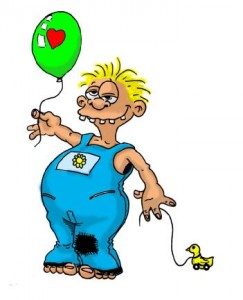 You may think we are backwards, but let me tell you a few things. Employment here is on the rise. 200 new jobs last month alone. People work here and don’t sit on their lazy asses. We make things work for us. No one is starving here. Everyone has a home. We are doing just fine. I won’t bore you with the great fishing and the camping. You just wouldn’t understand the joy of it anyway.
You may think we are backwards, but let me tell you a few things. Employment here is on the rise. 200 new jobs last month alone. People work here and don’t sit on their lazy asses. We make things work for us. No one is starving here. Everyone has a home. We are doing just fine. I won’t bore you with the great fishing and the camping. You just wouldn’t understand the joy of it anyway.
So hope that you survive the summer. I just love it that I can go anywhere and not worry about locking my doors, having my car stolen, not getting the finger every 5 minutes while driving, breathing clean fresh air, and the beauty of nature all around me. I have no complaints at all.
Do you?
Phillipsburg, Missouri
P.S. Hey, you can try to bring me down with nasty comments, but I laugh at you for being so stupid for complaining while still living in the [sic] best city of the world. Hillbillies rule!
Swedish supergroup ABBA visits Dick Cavett in 1981. Very releaxed Q&A.
Tags: ABBA, Dick Cavett
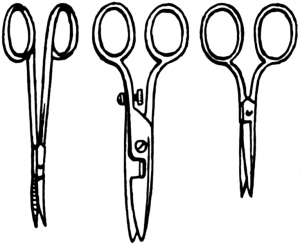
"Carlo took a pair of scissors, and in endeavoring with them to cut the gold chains and earrings he stabbed her with the points in the head, ears and shoulders."
The results of a messy marital breakup in Old New York were recorded in the August 14, 1885 edition of the Brooklyn Daily Eagle. An excerpt:
“Carlo Lepro, an ill favored Italian, hailing from 819 Mott Street, New York, was before Justice Nacher this morning on complaint of his pretty little gypsy looking 16 year old wife. She says that having left him to live under the protection to a fellow countryman named Joseph the Fish, at 158 North Fifth Street, Carlo came after her and demanded a large amount of jewelry with which he had decorated her. One her refusal to give it up, she says, Carlo took a pair of scissors, and in endeavoring with them to cut the gold chains and earrings he stabbed her with the points in the head, ears and shoulders. Defendant denied stabbing his wife, and stated that at the time he sought to repossess himself of the jewelry he had commenced divorce proceedings against her. The justice held the accused in a bond of $500 to answer to the charge of assault and battery in the second degree. Counselor Donnelly, who appeared for the accused, wishing to impeach the character of the woman, stated that on July 6 she had been arrested on the charge of appropriating $50 worth of property from her mother.”
Tags: Carlo Lepro, Counselor Donnelly, Joseph the Fish, Justice Nacher
Neurologist V.S. Ramachandran briefly discusses bizarre brain disorders.
Tags: V.S. Ramachandran
Ray Bradbury explains to Oriana Fallaci why we should travel into space, in the 1966 book, If The Sun Dies:
For the same reason that makes us bring children into the world. Because we’re afraid of death and darkness, and because we want to see our image reflected and perpetuated to immortality. We don’t want to die, but death is there, and because it’s there we give birth to children who’ll give birth to other children and so on to infinity. And this way we are handed down to eternity. Don’t let us forget this: that the Earth can die, explode, the Sun can go out, will go out. And if the Sun dies, if the Earth dies, if our race dies, then so will everything die that we have done up to that moment. Homer will die, Michelangelo will die, Galileo, Leonardo, Shakespeare, Einstein will die, all those will die who now are not dead because we are alive, we are thinking of them, we are carrying them within us. And then every single thing, every memory, will hurtle down into the void with us. So let us save them, let us save ourselves. Let us prepare ourselves to escape, to continue life and rebuild our cities on other planets: we shall not long be of this Earth! And if we really fear the darkness, if we really fight against it, then, for the good of all, let us take our rockets, let us get well used to the great cold and heat, the no water, the no oxygen, let us become Martians on Mars, Venusians on Venus, and when Mars and Venus die, let us go to the other solar systems, to Alpha Centauri, to wherever we manage to go, and let us forget the Earth. Let us forget our solar system and our body, the form it used to have, let us become no matter what, lichens, insects, balls of fire, no matter what, all that matters is that somehow life should continue, and the knowledge of what we were and what we did and learned: the knowledge of Homer and Michelangelo, of Galileo, Leonardo, Shakespeare, of Einstein! And the gift of life will continue.•
More from If The Sun Dies:
Tags: Oriana Fallaci, Ray Bradbury
The Guardian has a few photos of what Airbus believes passenger planes may look like in 2050: a panoramic view, smart chairs and virtual golf. I think four decades from now people will still prefer the womb-like ignorance of the enclosed cabin to the jaw-dropping view.
This classic 1898 photograph of New York City’s Ragpicker’s Row was taken by the famed muckraking journalist Jacob Riis. This impoverished section of the city was described (in the most offensive manner possible) in a 1879 New York Times article, “Flowers for the Poorest.” In that piece, a journalist tagged along with the well-meaning but dopey Ladies’ Flower and Fruit Mission, as members of the group visited the poorest quarters of Manhattan and handed out free flowers. An excerpt:
“The visitors shook loose from the crowd of children that clung to them begging for flowers, and made their way to Mulberry-street, in search of ‘Ragpicker’s Row.’ They found it at Nos. 56 and 59, and here encountered poverty in the most squalid and filthy aspects. In the little courts lying between the front and rear houses water stood in sickening fetid pools. The houses swarmed with the Italians who collect refuse, rags, bones, and bits of paper from the ash-barrels, or who work on the garbage scows, and bring back to the City much of the refuse matter once thrown away as worthless. In these houses and in these yards this reeking refuse is sorted, dried, and made up into bales. Men, women, and children engage in the work, and all are alike dirty and ragged to a degree. Most of the men are low-browed ugly-looking fellows, and many of the women are toothless hags. Occasionally there is to be seen among them a young woman holding her swathed bambino in her arms, whose face is so beautiful that, with the flat head-dress–which many of them still wear–she might be the original of the Italian Madonna. These people were the most clamorous for the flowers of any kind that had been met; nor did they wait to be bidden, but many of them helped themselves from the baskets, laughing at the efforts of the visitors to prevent them and to secure an even distribution. In this way the baskets were quickly emptied, and the visitors were glad when they were, and they were at liberty to escape from the filthy yard and their noisy occupants.”
Tags: Jacob Riis
CONFEDERACY OF DUNCES SEQUEL – $25 (U.S.A.)
I HAVE WRITTEN A SEQUEL TO THE CLASSIC NOVEL A CONFEDERACY OF DUNCES BY THE LATE JOHN KENNEDY TOOLE. IT’S CALLED “AN ARMY OF IDIOTS’
I WANT TO SELL MY RIGHTS FOR THE SALE IS THIS BOOK WORLDWIDE. I’M CURRENTLY SELLING IT ONLINE. E-MAIL ME IF YOU ARE INTERESTED. IT’S FOR SALE EXCLUSIVELY FOR $25K
I’M DESPERATE AS I’M GOING THROUGHT A HAIRY DIVORCE.
THANKS!
AUSTIN TEUTSCH
AUTHOR
AN ARMY OF IDIOTS
Paul Romer’s recent TED Talk about the concept of charter cities.
Tags: Paul Romer
The Atlantic tracked down (most of) Apple’s first ten employees to see what they’re doing today. An excerpt:
“#8 Chris Espinosa
Chris Espinosa was working at Apple part-time in high school.
Chris Espinosa joined Apple when he was 14, and still in high school. He’s still with the company today. On his personal blog he said he ended up with employee number eight because when CEO Michael ‘Scotty’ Scott was giving out numbers, he was at school. He arrived late and ended up with the number.”
Tags: Chris Espinosa
From “The Lost City Of Z,” the 2005 New Yorker article by the great David Grann about Colonel Percy Harrison Fawcett, who came to a mysterious end in the 1920s while exploring an isolated Amazonian civilization:
“In the first decades of the twentieth century, Fawcett had been acclaimed as one of the last of the great amateur archeologists and cartographers—men who ventured into uncharted territories with little more than a machete, a compass, and an almost divine sense of purpose. Fawcett survived in the jungle for years at a time, without contact with the outside world, often subsisting for days on a handful of nuts; he was ambushed by hostile tribesmen, many of whom had never seen a white man before; he emerged with maps of regions from which no expedition had returned.
Yet it was his ‘quest,’ as Fawcett called it, to find Z that most captivated Lynch. For centuries after the discovery of the New World, many Europeans believed that a fantastical kingdom of untold wealth was concealed in the ethereal landscape of the Amazon. In 1541, Friar Gaspar Carvajal, a member of the first European expedition to descend from the Andes into the Amazon, reported glimpses of white Indians and women warriors who resembled the mythical Greek Amazons. One early map of South America was adorned with minotaurs and headless beings with eyes in their chests, and well into the twentieth century the Amazon remained, as Fawcett put it, ‘the last great blank space in the world.’
Lynch’s research made him feel certain that Fawcett, unlike so many of his predecessors, was not a soldier of fortune or a crackpot. Fawcett was a recipient of the Gold Medal, the highest honor bestowed on an explorer by the Royal Geographical Society; a skilled mapmaker; and a decorated hero of the First World War. He knew the Amazon as well as anyone. His younger son, Brian, said of him, ‘True, he dreamed; but his dreams were built upon reason, and he was not the man to shirk the effort to turn theory into fact.'” (Thanks Electric Typewriter.)
•••••••••
Grann discusses the topic with that pretend pablum-puker Stephen Colbert:
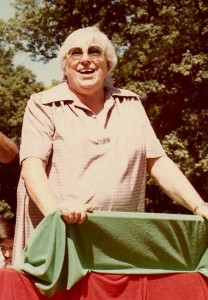
O’Hair was murdered in 1995 by a typesetter who worked for American Atheists. (Image by Alan Light.)
From the 1965 Playboy interview with Madalyn Murray O’Hair, the arch-atheist who sued to get prayer out of public schools and was dubbed “The Most Hated Woman in America” during her lifetime:
Playboy:
What led you to become an atheist?
Madalyn Murray O’Hair:
Well, it started when I was very young. People attain the age of intellectual discretion at different times in their lives — sometimes a little early and sometimes a little late. I was about 12 or 13 years old when I reached this period. It was then that I was introduced to the Bible. We were living in Akron and I wasn’t able to get to the library, so I had two things to read at home: a dictionary and a Bible. Well, I picked up the Bible and read it from cover to cover one weekend — just as if it were a novel — very rapidly, and I’ve never gotten over the shock of it. The miracles, the inconsistencies, the improbabilities, the impossibilities, the wretched history, the sordid sex, the sadism in it — the whole thing shocked me profoundly. I remember l looked in the kitchen at my mother and father and I thought: Can they really believe in all that? Of course, this was a superficial survey by a very young girl, but it left a traumatic impression. Later, when I started going to church, my first memories are of the minister getting up and accusing us of being full of sin, though he didn’t say why; then they would pass the collection plate, and I got it in my mind that this had to do with purification of the soul, that we were being invited to buy expiation from our sins. So I gave it all up. It was too nonsensical.•
______________________
“Madalyn,” a 30-minute film from the 1970s:
Tags: Madalyn Murray O'Hair

